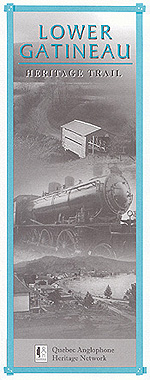
The Gatineau River was a wilderness thoroughfare through unbroken Laurentian forest.
Before loggers and farmers cleared its banks, the 275-kilometre long waterway served Algonquin hunters as their main route to the game-rich hinterlands. The river was a link in a vast First Nations trade system joining Huron and Nipissing people in the Great Lakes with Montagnais Innu near Lac Saint-Jean.
The river’s namesake, Nicolas Gatineau, was a notary and merchant from Trois-Rivières who traded for furs in the Ottawa River in the late 1600s.
English-speaking settlers came to the Lower Gatineau in the early 1800s by way of Wrightstown, the future city of Hull. A chief source of squared logs for Britain’s shipyards, the great pine and oak trees of the Ottawa Valley fell swiftly before the woodcutter’s axe.
As the forests were depleted, leading wood merchants, including Philemon Wright, George Hamilton, C.A. Low, Thomas McGoey and the Gilmours turned their gaze upon the Gatineau Hills. By the 1830s the Gatineau valley was the main source of timber in the Ottawa River. In wintertime, loggers headed north along the river to lumber camps. Come spring, the trees they’d felled were floated south . The annual log drive was a Gatineau tradition for more than 150 years.
Many historic villages along this Heritage Trail began as stopping places and supply points serving the wood trade. The oldest establishments at Chelsea, Wakefield, Farrellton and Low were inns, horse stables and storehouses. River hamlets such as Kirks Ferry, Cascades, Tenaga, Burnett, Larrimac and Gleneagle were abandoned in the 1920s to make way for hydroelectric dams.
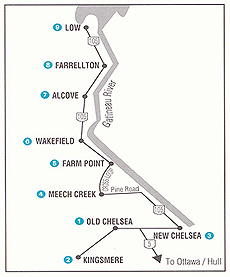 HOW TO GET THERE
HOW TO GET THERE
This Heritage Trails tour begins in the village of Old Chelsea, about a 15-minute drive from downtown Ottawa. Head north through Hull on Autoroute 5 and take exit 12, turning left onto Old Chelsea Road.
OLD CHELSEA
The oldest pioneer markers in the Lower Gatineau are found beyond the iron gates of the Protestant graveyard, across the street from l’Agaric Restaurant and behind the old Dunn Hotel (1901) at 253 Old Chelsea Road. Buried here are such leading pioneers as Massachusetts native Thomas Wright and Asa Meech, a preacher, teacher and doctor for whom Meech Lake in nearby Gatineau Park is named.
Brooks’ Creek, which flows past the cemetery, was first harnessed for saw and grist mills by
another New Englander. Thomas Brigham was Hull founder Philemon Wright’s son-in-law and a businessman who emigrated to Hull Township from Chelsea, Vermont.
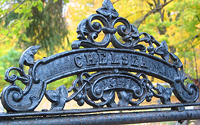 By the end of the 1820s, Irish farmers outnumbered their American counterparts. Some had come to Canada as labourers to dig the Rideau Canal. Others arrived in the 1840s fleeing famine in their homeland. St. Stephens Catholic Church (1845) on Old Chelsea Road, made of stone from quarries used to build Canada’s Parliament Buildings, is a reminder of the strong Irish influence on early Gatineau settlements.
By the end of the 1820s, Irish farmers outnumbered their American counterparts. Some had come to Canada as labourers to dig the Rideau Canal. Others arrived in the 1840s fleeing famine in their homeland. St. Stephens Catholic Church (1845) on Old Chelsea Road, made of stone from quarries used to build Canada’s Parliament Buildings, is a reminder of the strong Irish influence on early Gatineau settlements.
The first town hall was built in 1876. The building still stands on the southeast corner of Autoroute 5 and Old Chelsea Road. A detailed guide to local heritage buildings is published by the Gatineau Valley Historical Society.
Gatineau Valley Historical Society
Telephone: (819) 827-4432
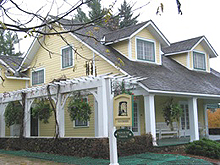 KINGSMERE (Gatineau Park)
KINGSMERE (Gatineau Park)
William Lyon Mackenzie King was a great admirer of Quebec’s Gatineau Hills and in 1902 the future Canadian prime minister bought land on Kingsmere Lake, a few kilometres from Old Chelsea. Here he built a cottage and extensive gardens. Upon his death in 1950 King bequeathed the estate to the Government of Canada. Today the Natonal Capital Commission (NCC) operates the Gatineau Park site as a major cultural attraction.
For more information call 1 800 465-1867
Gatineau Park website: https://ncc-ccn.gc.ca/places/gatineau-park
NEW CHELSEA
A short drive east along Old Chelsea Road brings visitors across Aut. 5, past the municipal hall and the English primary school toward the community of New Chelsea. Note the typical Gatineau fanlight in the Gardner Church House (1870) directly opposite the stop sign on Route 105.
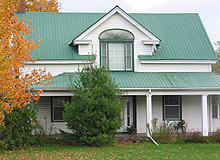 Church was a master carpenter who styled his home after neoclassical building traditions popular with Gatineau residents during the Victorian period. Many of Church’s outside design details remain intact: the symmetry of doors and windows, the columned porch and a transom above the front entrance stand out.
Church was a master carpenter who styled his home after neoclassical building traditions popular with Gatineau residents during the Victorian period. Many of Church’s outside design details remain intact: the symmetry of doors and windows, the columned porch and a transom above the front entrance stand out.
New Chelsea was home to the famous Gilmour family, whose extensive lumbering operations shaped development of the Lower Gatineau. The Gilmours financed a stone-filled dam, a mill and a two-mile lumber slide on the Gatineau River at Chelsea Falls. All vanished under water in 1926 when the Gatineau Power Co. built the Chelsea Dam.
Today Mill Road leads past the United Church and over the railroad tracks to the site of Chelsea’s former railroad station. The station was demolished in 1970 but not the tracks, which now shuttle trainloads of tourists from all over the world into the hills upriver aboard the Hull-Chelsea-Wakefield Steam Train.
Editor's note: As of 2011, the steam train is no longer functioning due to a wash-out.
Just north of the village watch for a sign indicating the entrance to the Chelsea Pioneer Cemetery.
 MEECH CREEK VALLEY
MEECH CREEK VALLEY
Continue up Route 105, over the top of the hill above the traffic light and La Vallée Motel, then veer left onto Pine Road. Drive a kilometre or so, then turn right onto Cross Loop Road. This road leads through gently rolling farmland of Meech Creek Valley across an old wooden covered bridge before merging with the highway. The land was expropriated in the 1970s and now forms part of Gatineau Park. At the peak of the lumber trade in the 1800s this narrow watercourse channeled logs to a sawmill at Farm Point.
FARM POINT
This tiny Gatineau hamlet boasts a handful of heritage buildings, including St. Clement’s Catholic Church (circa 1920). The village’s original schoolhouse has been remodeled as a private home.
Before his business collapsed during the Depression of the 1930s, Gatineau electricity pioneer Freeman Cross ran a sawmill and a toy factory here. Cross dammed the Meech Creek near its outlet on the river in the early 1900s and installed the valley’s first hydroelectric plant about 1910.
WAKEFIELD
Steeped in the history of the log drive, this village near the junction of the Lapêche and Gatineau rivers has lured cottagers and tourists since the early 1900s. Before that, Wakefield’s lively streetfront served the needs of farms and distant logging camps.
The area’s first homesteaders were Joseph Irwin and Mary Pritchard, who came to historic Wakefield Township via Bytown (Ottawa) from Northern Ireland in 1829. Ten other northern Irish families eventualy cleared acreages near the townsite.
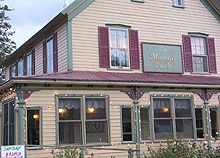 Many of Wakefield’s original hotels, churches, stores and homes remain. The Earle House (circa 1880) on the corner of Valley and Riverside drives, belonged to Robert Earle, a carpenter, carriage-maker and blacksmith. Patterson’s General Store at 740 Riverside Dr. (circa 1880), now a gift shop, retains much of its original interior. The Wakefield train station (1892) has operated as a restaurant since 1970. Les Trois Érables, an elegant doctor’s residence built in 1896 today functions as a bed-and-breakfast.
Many of Wakefield’s original hotels, churches, stores and homes remain. The Earle House (circa 1880) on the corner of Valley and Riverside drives, belonged to Robert Earle, a carpenter, carriage-maker and blacksmith. Patterson’s General Store at 740 Riverside Dr. (circa 1880), now a gift shop, retains much of its original interior. The Wakefield train station (1892) has operated as a restaurant since 1970. Les Trois Érables, an elegant doctor’s residence built in 1896 today functions as a bed-and-breakfast.
A Scottish millwright and stonemason named William Fairbairn built Wakefield’s first grist mill beside the waterfalls on the Lapêche River in 1838. Fellow countryman David Maclaren, a hardware merchant from Glasgow, built a sawmill in the centre of the village in the 1840s then added Fairbairn’s grist mill to his operations. Later he built a large brick three-storey woolen mill.
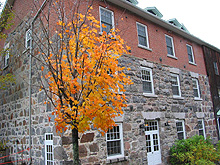 The mill complex was a leading employer in the Gatineau until the 1930s. It has been converted into a 26-room inn. The brick-clad Edwardian-Gothic style Maclaren House (1860) next door is used for conferences.
The mill complex was a leading employer in the Gatineau until the 1930s. It has been converted into a 26-room inn. The brick-clad Edwardian-Gothic style Maclaren House (1860) next door is used for conferences.
The MacLaren family cemetery behind the mansion contains the grave of Canada’s prime minister Lester B. Pearson. The Wakefield Covered Bridge, a striking replica of an older structure destroyed by fire in 1984, is a popular visitor attraction.
A number of Wakefield homes have been awarded heritage plaques by the Municipality of Lapêche, many of which can be seen on Burnside Avenue.
 ALCOVE
ALCOVE
Once called North Wakefield, this small settlement was a busy sawmill town and ferry crossing. James and Judith Pritchard, farmers from Northern Ireland, first settled here in 1834 and their large white wooden family homestead (circa 1850s) still stands at 49 chemin de la Rivière, part of the original Gatineau River road. Much of the farm country to the west of the hamlet along Maple Drive was cleared by Pritchards descendants.
Before Route 105 was built, the narrow tree-lined street along the river was Alcove’s main thoroughfare. The brick church (57 chemin de la Rivière), Alcove United, was built in 1889 as a Methodist meeting house. The North Wakefield General Store, last run by Oliver Draffin, sits abandoned nearby. The Alcove Ferry operated from an approach to the river a few metres further north. The former schoolhouse, now a private residence, stands behind some trees on the other side of the railbed.
FARRELLTON
Veer left onto Plunkett Road, off Route 105 to admire the St. Camillus Catholic Church and manse, built by local Irish colonists. The name honours Patrick Farrell, a Gatineau pioneer who opened a general store here in the 1800s. Farrellton prospered as a supply depot for lumber camps and at one time supported a blacksmith, a sawmill and a butter factory.
LOW
One of three hydroelectric plants built on the river between 1926 and 1932, the Paugan Dam spans a 35-metre deep gorge at Low. Today there is a good road leading across the dam offering visitors a close-up view of the power plant, the gorge, the head-pond and the log chute.
After a century of harvest, lumber-grade trees grew scarce. Pulp and paper mills emerged as the leading consumer of Gatineau wood. In 1921 the U.S.-owned International Paper Company bought up water rights and timber holdings in the Gatineau through its subsidiary, the Canadian International Paper Co. The company dammed the river at Low, Chelsea and Farmer’s Rapids to power its paper mill at Templeton (now Gatineau).
The names of many early settlers can be seen in the cemetery adjacent to Low United Church. Brook’s Hill farm at 34 Brook’s Hill Road was home to a family of stagecoach operators who carried freight and passengers upriver from Chelsea to Maniwaki before the arrival of the railroad in the 1890s.
This guide is presented by the Quebec Anglophone Heritage Network and is made possible by a grant from Economic Development Canada and the Department of Canadian Heritage. Space constraints preclude mention of all possible sites. Thanks to Jay Atherton, Ernie Mahoney and Adrienne Herron of the Gatineau Valley Historical Society for their help. For more information call the QAHN office at (819) 564-9595 or toll free within Quebec at 1 (877) 964-0409.![]()
![]()